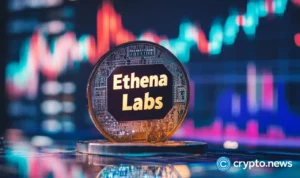- By integrating Chainlink Data Streams, Ostium ensures real-time, low-latency, and accurate crypto market pricing.
- This technology, which combines off-chain speed with on-chain verifiability, enhances trading precision while mitigating risks like frontrunning, making it ideal for derivatives and high-frequency trading.
Ostium Labs became the largest decentralized perpetual exchange on Arbitrum with a total trading volume of more than $5 billion. This is an important milestone that shows the direction of the growing influence on the platform in the decentralized finance (DeFi) space.
It’s driven by a strong focus on real-world asset (RWA) markets and a sophisticated backend powered by Chainlink Data Streams.
Source: Ostium Labs
To maintain performance and user trust as trading volumes grow, Ostium integrated Chainlink Data Streams into its infrastructure. This allows the exchange to provide real-time, flash, and precise pricing of crypto markets, which is paramount to high-leverage, real-time activity. The strategic partnership between Ostium and Chainlink involves low-latency data, transparency, and a composable architecture that Arbitrum functions on the Layer 2 network.
The Role Of Chainlink Data Streams
Chainlink Data Streams provide real-time market information based on the pull style that enables decentralized applications to demand data as the demand arises. The system replaces the push-based oracles with their periodic updates or deviation threshold based on price-to-price bounds. The architecture and technology implementation provide latency and gas savings on trading applications through on-demand access to high-frequency pricing information.
Intended to fulfill the performance requirements of DeFi protocols, Chainlink Data Streams has the off-chain convenience of speed with on-chain verifiability. All data values collected by a smart contract are signed cryptographically and subsequently verified immediately on access.
The model guarantees that the applications are served timely with up-to-date information at the point of service, which eliminates the possibility of receiving stale prices and works against risks such as frontrunning. It is sub-second resolution, and would thus be suitable in a latency-sensitive application like derivatives, prediction markets, or algorithmic trading.
In recent deployments, it has become clear that the infrastructure provided by Chainlink can be used as the central network on which new generations of DeFi solutions can be built. It helps them operate with centralized-exchange speed while preserving blockchain-level transparency and security.
Ostium’s Vision For Real-World Asset Perpetuals
Ostium Labs was established to fill the gap between the classical financial market and the decentralized trading system. Ostium is its flagship product, and it is a decentralized perpetual futures-trading exchange that is specially made to trade perpetual futures on RWAs, such as commodities, currencies, and indices.
First, using a synthetic model, the platform enables trading of price movements with the use of stablecoins like USDC. Assets are traced through internal oracles that set prices and fees on an evolving basis based on time market conditions. The protocol is ultimately set to incorporate tokenized real-world collateral such as indexes, treasuries, and even real estate.
Being always-on and being designed with a consumer approach, Ostium is organized in a way that will accommodate retail as well as institutional traders. The exchange focuses on precision, as it utilizes its own coding structure engines, delivers information in under one second, and employs adjustable charge engineering to manage liquidity and volatility.
By integrating blockchain-native infrastructure with conventional asset exposure, Ostium establishes a novel set of standards for efficiently, transparently, and scalably managing RWA trading.
Read the full article here










